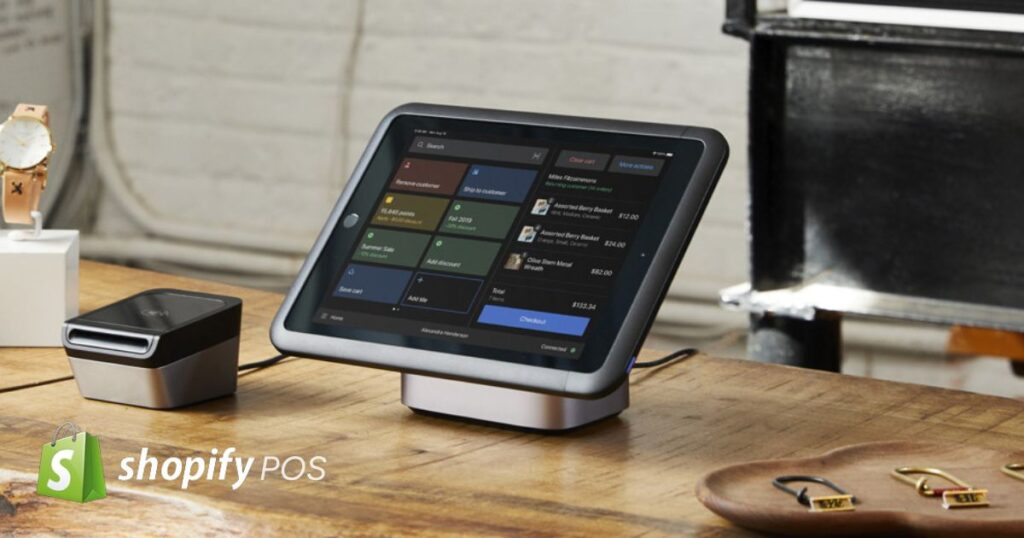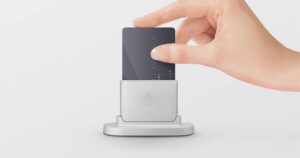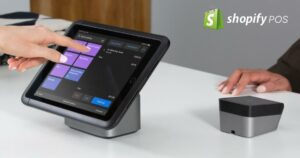Shopify is an e-commerce platform that allows businesses to create online stores and sell products online. However, Shopify also offers a point-of-sale (POS) system for businesses that want to sell products in a brick-and-mortar store.
The Shopify POS system is designed to work seamlessly with the Shopify e-commerce platform, allowing businesses to manage their inventory, orders, and customers all in one place.
Shopify POS Hardware Retailers Needs
Although you may not need each and every piece of point-of-sale (POS) hardware on our list to begin selling in person, the tools and accessories listed here are the kind of POS gear that the vast majority of companies buy to operate brick-and-mortar stores.
A very short time ago, point-of-sale (POS) systems were powered by cumbersome computers. Tablets and smartphones, on which POS software may now be installed, can be converted into streamlined mobile POS registers. Each one is advantageous in its own unique way.
Tablet
Tablets, such as Apple’s iPad, are transportable mini-computers that have touchscreen displays. In contrast to a laptop, it typically consists of a flat surface and a keyboard that is shown on the screen.
Tablets may have POS software installed on them, allowing users to do tasks such as looking up items and customer profiles, processing transactions, tracking inventory, and many other activities.
Tablets are valuable in retail environments because they provide a sleeker, more flexible alternative to the cumbersome and fixed point-of-sale (POS) hardware of the past. You also get a more substantial screen, which makes tasks such as searching for items, reading reports, and managing inventories simpler.
Smartphone
A smartphone, such as an iPhone, is a mobile device that is equipped with internet access and is used to make phone calls, run applications, and do a wide variety of other tasks.
In a retail environment, smartphones may be used for a variety of functions. You are able to download point-of-sale software onto a smartphone, and then use the smartphone as a point-of-sale terminal to ring up customers, search for items, and ring up customers.
You can even utilize the camera on your smartphone as a barcode scanner thanks to Shopify POS. This comes in handy whether you’re scanning items at the register or doing an inventory count.
When you want the flexibility to take debit, credit, and mobile wallet payments with minimum hardware, a smartphone is an excellent alternative for selling at events and pop-up shops since it is smaller than a tablet. This makes it an ideal choice for selling at events.
Tablet stand
Tablets are wonderful because of their mobility; but, there are instances when you want to merely store them in one location. At the checkout counter, tablets may be held in place by a tablet stand, making them both simpler to reach and operate.
Certain tablet stands are designed to rotate so that consumers may look over their purchases and sign for their own transactions. In fact, the law in some states mandates that retailers have a POS system that includes a display that is oriented toward the customer.
Barcode scanner
A barcode scanner is a portable handheld device that has a laser and reads the barcodes that are printed on products. Customers are rung up on this device, purchase orders are taken in, and inventory counts are carried out with this device.
Instead of manually looking for goods in your POS system and adding them to a customer’s basket, you can save time and increase efficiency by using a barcode scanner.
Ready to Try Shopify POS for Free?
You can test out whether Shopify is right for your business, without spending a thing,
we always recommend testing it before buying!
Card reader
Card readers are types of payment terminals that handle transactions made with credit and debit cards. It is possible to accept contactless payments through mobile wallets thanks to the Near Field Communication (NFC) technology that is built into certain card readers.
The term for this practice is “tap to pay.” While looking for a card reader, be sure to opt for one that can handle contactless payments in addition to card payments. Card readers, when combined with a cash drawer, make it possible to take all common forms of payment and so increase sales.
Cash drawer
Cash and change are kept inside a cash drawer. The cash drawer pops up whenever there is a cash transaction, allowing employees to collect cash payments and provide customers with their correct change.
Since a cash drawer is equipped with bins that categorize dollars and coins according to their worth, the process of making deposits and producing a change is streamlined and streamlined.
The cash monitoring sessions that come standard with point-of-sale systems like Shopify POS allow you to monitor your daily cash transactions and bring your cash drawer into better balance.
Receipt printer
A receipt printer is a little printer that sits on top of a countertop and produces paper receipts for the benefit of your clients.
These receipts provide information that is helpful, such as the things that were bought, the product prices, the tax amounts, as well as the date and location where the transaction took place.
The printer generates two copies of each receipt: one for the client and one for the merchant if a physical signature is required for a card transaction. Consumers should save their receipts in case they need to make a return or exchange for an item.
Customers who need printed receipts may have them promptly and conveniently provided by a receipt printer, which is one of the many reasons why receipt printers are so important.
Receipt paper rolls
Receipts are often printed on rolls of receipt paper. They’re necessary for printing receipts and giving consumers a tangible record of their transactions, so you can’t do without them.
Barcode label printer
A barcode label printer is a specialized printer that produces barcode labels, often onto sticker paper. These labels are typically used in retail environments. You may generate barcode labels for your product tags right in your own office if you have a label printer.
It is helpful to have a barcode label printer because, when used in conjunction with a barcode scanner, it allows you to more quickly add products to a customer’s shopping basket and finish the checkout process.
Barcode labels
Stickers or cardboard that have been printed may serve as the basis for barcode labels, which are then affixed to product tags. Check to be that the labels you buy are suitable for use with the barcode label printer you have.
Ready to Try Shopify POS for Free?
You can test out whether Shopify is right for your business, without spending a thing,
we always recommend testing it before buying!
How to Choose the Appropriate Point-of-Sale (POS) Hardware?
You should go through the following and keep in mind the following points to ensure that you get the POS hardware that is most suitable for your requirements.
Make a list of the procedures and routine
While there are a few components of point-of-sale (POS) hardware that are necessary for all shops, there is no standard configuration that works for all businesses. The hardware that you employ will be determined by the configuration of your shop.
Consider the sort of experience you want your consumers to have while they are checking out. You will need a tablet, a tablet stand, a card reader, a cash drawer, as well as a receipt and barcode printing hardware and accessories in order to have a conventional cash wrap counter.
If you want to keep lines as low as possible using mobile checkout, all you will need is a smartphone or a tablet and a card reader. This is also all you will need if you are holding a pop-up store.
Investigate all of your available choices online
It is not necessary to rush out and get the very first piece of hardware or accessory that you come across when there are so many possibilities available.
Since purchasing point-of-sale (POS) hardware is a significant financial commitment, it is essential to make an informed decision. Carry do some study.
Retail communities online
An online retail community is a fantastic resource for locating tried-and-true point-of-sale (POS) hardware, regardless of whether you are just starting out in the business world or are looking for advice from individuals who already run successful retail establishments.
Search for communities on Reddit, such as the Ask Retail and RETAIL subreddits, as well as groups on LinkedIn and Facebook.
Research
After you get your list of hardware alternatives down to a few choices, the next step is to research evaluations of these items.
You may find in-depth evaluations of many products, including tablets, cellphones, iPad stands, barcode scanners, and more on the websites of their respective manufacturers, on review sites like G2, and on YouTube.
Examine the many types of hardware that POS suppliers supply
The majority of point-of-sale software companies supply hardware that has been tried and tested by their clients and has received positive feedback. It is more convenient and will help you get set up quicker if you purchase both your gear and software from the same site.
Talk to the business people
In addition to interacting with groups online, it is essential to have conversations with other businesses in your local neighborhood. Establish relationships with the proprietors of the nearby companies.
Participate in the activities of your neighborhood’s business improvement district or trade group. You should poll the people in your town to find out what sort of gear has served them the best throughout the years.
Conclusion
When it comes to point-of-sale (POS) hardware, there is no “one size fits all” option. It is essential that you make the effort to carefully evaluate the specific requirements of your company and locate the hardware configuration that most adequately satisfies those specifications.
Your retail establishment will be able to function at a higher level of productivity if you invest in the appropriate hardware for it.






